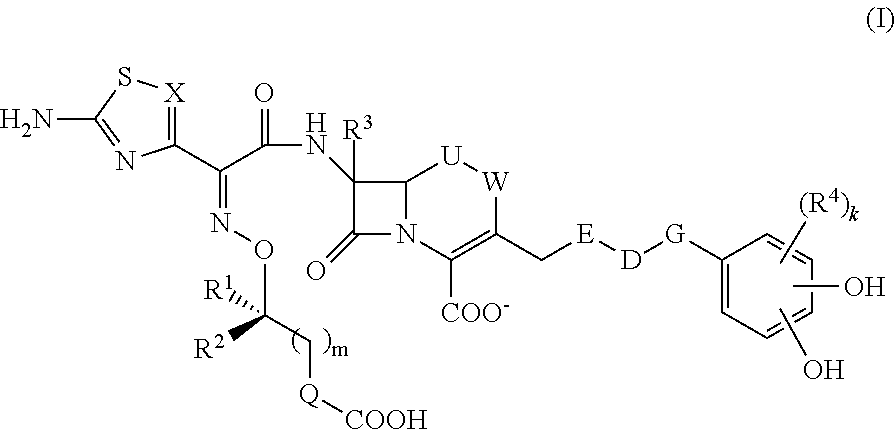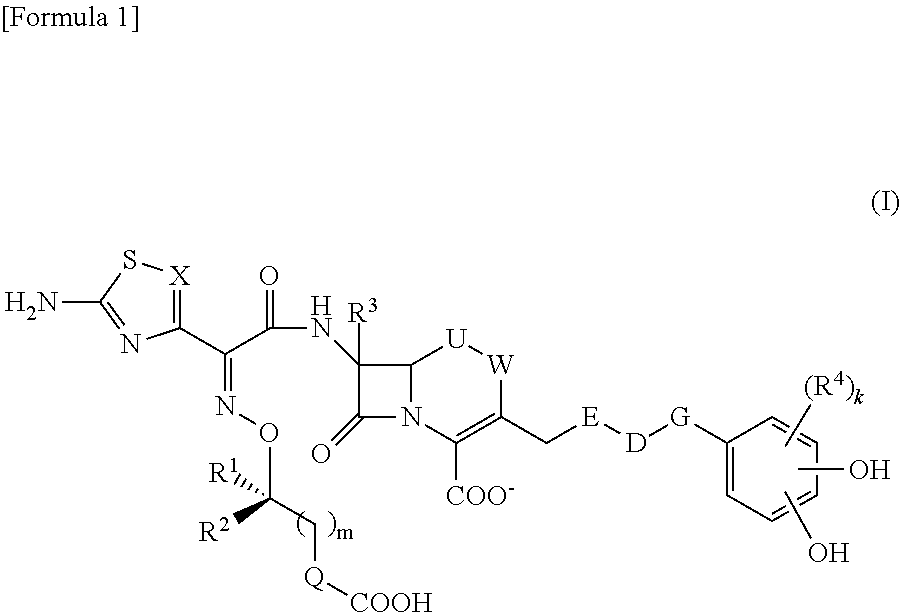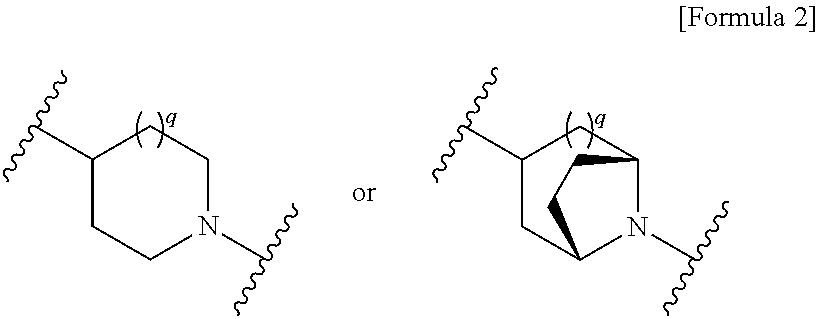Cephem compound having catechol group
a technology of catechol group and compound, applied in the field of cephem compounds, can solve problems such as clinical problems, and achieve the effects of broad antimicrobial spectrum, potent antimicrobial activity, and potent antimicrobial activity
- Summary
- Abstract
- Description
- Claims
- Application Information
AI Technical Summary
Benefits of technology
Problems solved by technology
Method used
Image
Examples
example 1
Synthesis of Compound (I-1)
[0300]
Step (1): Compound 1a→Compound 1b
[0301]Compound 1a (5.26 g, 10 mmol) was suspended N,N-dimethylformamide (50 mL). Hydrazine monohydrate (0.73 mL, 15 mmol) was added thereto with stirring, and then stirred at room temperature for 14 hours. Water was added to the reaction solution, the resulting solid was filtrated, washed with isopropanol, then diisopropyl ether, and then dried in vacuo to yield Compound 1b (4.03 g, 91%>.
[0302]1H-NMR (DMSO-d6) δ: 9.42 (1H, br s), 7.43 (2H, d, J=8.5 Hz), 7.31 (2H, d, J=8.5 Hz), 7.17 (1H, d, J=8.5 Hz), 7.09 (1H, d, 8.2 Hz), 6.97 (2H, d, J=8.4 Hz), 6.87 (2H, J=8.4 Hz), 5.14 (2H, s), 4.88 (2H, s), 4.43 (2H, br s), 3.77 (3H, s), 3.75 (3H, s).
[0303]MS: 443.24 (M+H).
Step (2): Compound 1b→Compound 1c
[0304]Compound 1b (5 g, 11.3 mmol) was dissolved in N,N-dimethylformamide (50 mL). Sodium hydrogen carbonate (1.14 g, 13.6 mmol) followed by chloroacetyl chloride (1.09 mL, 13.6 mmol) were added thereto, and then stirred at room t...
example 2
Synthesis of Compound (I-2)
[0320]
step (1): Compound 2a→Compound 2b
[0321]To Compound 2a (5.25 g, 31 mmol), which was synthesized as described in Tet. Lett. 1991, 32, 1245, water was added (35 mL), and the heated at reflux for 8 hours. The reaction solution was cooled to room temperature followed by concentration in vacuo, and then a mixed solution of isopropanol / diisopropyl ether was added to the resulting residue. The resulting solid was filtrated, and then dried in vacuo to yield Compound 2b (3.91 g, 99%).
[0322]MS: 142.16 (M+H).
[0323]1H-NMR (CD3OD) δ: 3.56-3.46 (2H, m), 3.35-3.25 (4H, m), 2.35-2.23 (2H, m), 1.94-2.02 (2H, m).
step (2): Compound 2b→Compound 2c
[0324]To Compound 2b (1.41 g, 10 mmol), thionyl chloride (15 mL) was added, and then heated at reflux for two hours. After evaporating thionyl chloride under reduced pressure, xylene was added thereto, and then concentrated in vacuo again. While stirring under ice-cooling, aqueous sodium azide (2.60 g, 40 mmol) solution (25 mL) ...
example 3
Synthesis of Compound (I-3)
[0340]
step (1): Compound 2e→Compound 3a
[0341]Compound 2e (40 mmol), which was prepared by the same method as Example 2, was cooled to −15° C. Methanol (80 mL) was added thereto, and then stirred at room temperature for 30 minutes. Ethyl acetate and water were added to the reaction solution, and then the organic layer was separated. The organic layer was washed with water, then saturated brine, and then dried with magnesium sulfate. Magnesium sulfate was then filtrated. After concentrating in vacuo, isopropanol was added to the resulting residue. The resulting solid was filtrated, and then washed with isopropanol, then diisopropyl ether. Concentrating and drying yielded Compound 3a (12.8 g, 73%) as a solid.
[0342]1H-NMR (DMSO-d6) δ: 7.61 (1H, d, 8.7 Hz), 7.44 (2H, d, J=8.4 Hz), 7.29-7.25 (3H, m), 6.98 (2H, d, J=8.4 Hz), 6.85 (2H, d, J=8.2 Hz), 5.18 (2H, s), 4.89 (2H, s), 3.81 (3H, s), 3.78 (3H, s), 3.74 (3H, s).
step (2): Compound 3a→Compound 3b
[0343]Compound...
PUM
| Property | Measurement | Unit |
|---|---|---|
| temperature | aaaaa | aaaaa |
| temperature | aaaaa | aaaaa |
| temperature | aaaaa | aaaaa |
Abstract
Description
Claims
Application Information
 Login to View More
Login to View More - R&D
- Intellectual Property
- Life Sciences
- Materials
- Tech Scout
- Unparalleled Data Quality
- Higher Quality Content
- 60% Fewer Hallucinations
Browse by: Latest US Patents, China's latest patents, Technical Efficacy Thesaurus, Application Domain, Technology Topic, Popular Technical Reports.
© 2025 PatSnap. All rights reserved.Legal|Privacy policy|Modern Slavery Act Transparency Statement|Sitemap|About US| Contact US: help@patsnap.com



